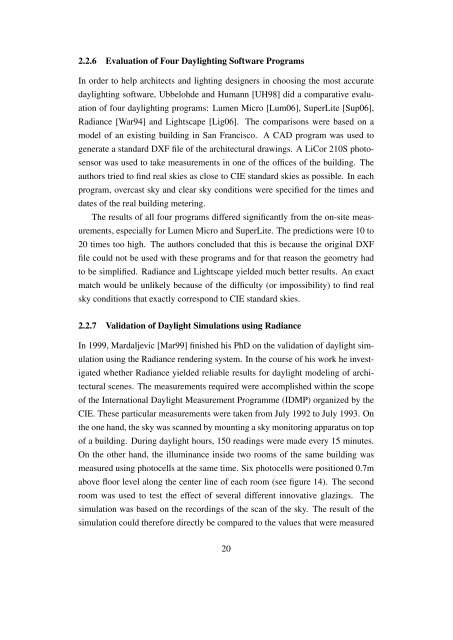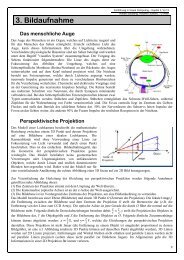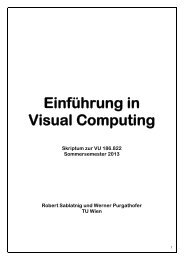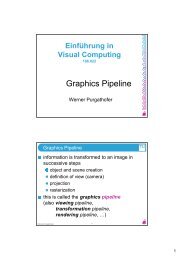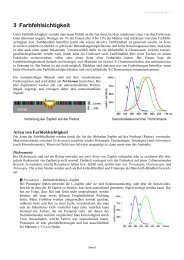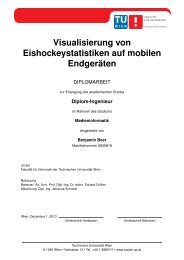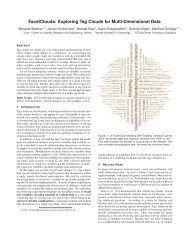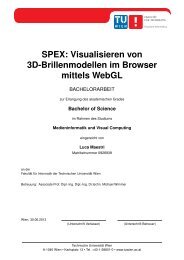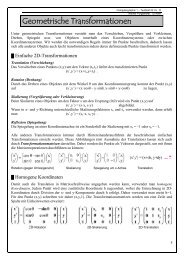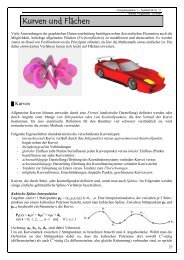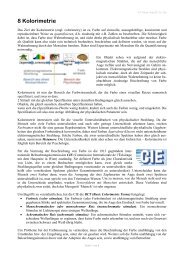Usability of Digital Cameras for Verifying Physically Based ...
Usability of Digital Cameras for Verifying Physically Based ...
Usability of Digital Cameras for Verifying Physically Based ...
You also want an ePaper? Increase the reach of your titles
YUMPU automatically turns print PDFs into web optimized ePapers that Google loves.
2.2.6 Evaluation <strong>of</strong> Four Daylighting S<strong>of</strong>tware Programs<br />
In order to help architects and lighting designers in choosing the most accurate<br />
daylighting s<strong>of</strong>tware, Ubbelohde and Humann [UH98] did a comparative evalu-<br />
ation <strong>of</strong> four daylighting programs: Lumen Micro [Lum06], SuperLite [Sup06],<br />
Radiance [War94] and Lightscape [Lig06]. The comparisons were based on a<br />
model <strong>of</strong> an existing building in San Francisco. A CAD program was used to<br />
generate a standard DXF file <strong>of</strong> the architectural drawings. A LiCor 210S photo-<br />
sensor was used to take measurements in one <strong>of</strong> the <strong>of</strong>fices <strong>of</strong> the building. The<br />
authors tried to find real skies as close to CIE standard skies as possible. In each<br />
program, overcast sky and clear sky conditions were specified <strong>for</strong> the times and<br />
dates <strong>of</strong> the real building metering.<br />
The results <strong>of</strong> all four programs differed significantly from the on-site meas-<br />
urements, especially <strong>for</strong> Lumen Micro and SuperLite. The predictions were 10 to<br />
20 times too high. The authors concluded that this is because the original DXF<br />
file could not be used with these programs and <strong>for</strong> that reason the geometry had<br />
to be simplified. Radiance and Lightscape yielded much better results. An exact<br />
match would be unlikely because <strong>of</strong> the difficulty (or impossibility) to find real<br />
sky conditions that exactly correspond to CIE standard skies.<br />
2.2.7 Validation <strong>of</strong> Daylight Simulations using Radiance<br />
In 1999, Mardaljevic [Mar99] finished his PhD on the validation <strong>of</strong> daylight sim-<br />
ulation using the Radiance rendering system. In the course <strong>of</strong> his work he invest-<br />
igated whether Radiance yielded reliable results <strong>for</strong> daylight modeling <strong>of</strong> archi-<br />
tectural scenes. The measurements required were accomplished within the scope<br />
<strong>of</strong> the International Daylight Measurement Programme (IDMP) organized by the<br />
CIE. These particular measurements were taken from July 1992 to July 1993. On<br />
the one hand, the sky was scanned by mounting a sky monitoring apparatus on top<br />
<strong>of</strong> a building. During daylight hours, 150 readings were made every 15 minutes.<br />
On the other hand, the illuminance inside two rooms <strong>of</strong> the same building was<br />
measured using photocells at the same time. Six photocells were positioned 0.7m<br />
above floor level along the center line <strong>of</strong> each room (see figure 14). The second<br />
room was used to test the effect <strong>of</strong> several different innovative glazings. The<br />
simulation was based on the recordings <strong>of</strong> the scan <strong>of</strong> the sky. The result <strong>of</strong> the<br />
simulation could there<strong>for</strong>e directly be compared to the values that were measured<br />
20


